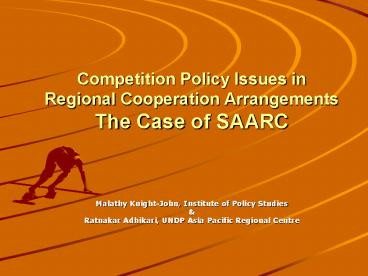Competition Policy Issues in Regional Cooperation Arrangements The Case of SAARC - PowerPoint PPT Presentation
1 / 11
Title:
Competition Policy Issues in Regional Cooperation Arrangements The Case of SAARC
Description:
Competition Policy Issues in Regional Cooperation Arrangements The Case of SAARC Malathy Knight-John, Institute of Policy Studies & Ratnakar Adhikari, UNDP Asia ... – PowerPoint PPT presentation
Number of Views:242
Avg rating:3.0/5.0
Title: Competition Policy Issues in Regional Cooperation Arrangements The Case of SAARC
1
Competition Policy Issues in Regional
Cooperation Arrangements The Case of SAARC
- Malathy Knight-John, Institute of Policy Studies
- Ratnakar Adhikari, UNDP Asia Pacific Regional
Centre
2
State of economies in the SAARC region
- Seven countries Bangladesh, Bhutan, India,
Maldives, Nepal, Pakistan, Sri Lanka. Eighth
country (Afghanistan in the process of
membership) - Relatively closed economies until the end of 80s
(except for Sri Lanka) - Since early 1990s started policy of economic
reform - Deregulation
- Privatisation
- Financial sector reform
- External sector reform
- Reduction in tariffs and QRs
- Removal of regulations on foreign investment
3
Regional trading agreements within SAARC
Framework
- Preferential trading arrangement (SAPTA) entered
into force in December 1995 proven a non-starter
due to positive list approach for the
liberalization of tariffs - Free trade agreement (SAFTA), to enter into force
from July 2006 - Shallow integration arrangement with a commitment
to fully liberalize trade in goods by 2016 - Talks on services and investment yet to begin
- Lengthy sensitive lists (upto 1,335 items at six
digit level) mean that protectionist tendency is
widely prevalent - Trade liberalization under SAFTA unlikely to
promote competition
4
Regional trade agreements outside SAARC
Framework
- Trade agreement with Thailand and Myanmar
- Five countries of the region (except Maldives and
Pakistan) are part of a trans-regional trade
agreement called Bay of Bengal Multi Sectoral
Technical and Economic Cooperation (BIMSTEC) - Shallow integration arrangements with a
commitment to liberalize goods, services and
investment by 2017 - Bilateral trade agreements
- e.g., India-Sri Lanka India-Nepal Pakistan-Sri
Lanka - Shallow agreements with liberalization of goods
only - India and Sri Lanka moving into a relatively
deeper integration arrangement through
Comprehensive Economic Partnership Agreement
5
Country-wise status of competition policy
- No well defined competition policy
- Competition laws limited experience
- India, Pakistan and Sri Lanka
- Some experience with the implementation of
competition laws - New laws are in the various stage of preparation/
implementation - Bangladesh prepared a draft but has not move far
enough - Nepal made a voluntary commitment to enact a
competition law at the time of its accession to
the WTO, but missed the deadline draft ready - Bhutan is mulling over a combination of
competition and consumer protection law - Maldives is not making any plans
6
Competition concerns within the Region
- Cross cutting
- Cartel
- Bid-rigging
- Price discrimination
- Exclusive dealing
- Country specific
- Public monopoly transforming into private
monopoly (e.g., Sri Lanka, Nepal) - Syndicate (e.g., Nepal and India trucks and
public transportation) - Tied selling (e.g., Nepal and India school
uniform) - Predatory pricing (e.g., Nepal airlines,
newspapers)
7
Cross border competition concerns
- International/regional cartels (like infamous
vitamin, heavy electrical equipment and graphite
electrodes cartels) - Export cartels (which provides immunity in many
jurisdictions including India and Pakistan) - Cross-border mergers and acquisitions
- Spill-over effects (mainly due to huge informal
trade) - Dumping (alleged dumping of battery and FMCGs)
- Abuse of market power by foreign investors (e.g,
Unilever in Bhutan)
8
Regional approachesSouth Asia at crossroads I
- Regional competition policy helps
- International/regional competition abuses require
regional solutions due to limited capacity to
prosecute them, acting individually - Rapid learning possibility
- Cooperation possible either through sharing of
information or positive comity - Cost effective pooling of resources and
expertise - Direct effect access to regional law to
challenge domestic competition abuses (e.g.,
UEMOA and Andean) as an interim solution, for
example, in South Asian LDCs not having domestic
laws
9
Regional approachesSouth Asia at crossroads II
- However, there are problems too
- Shallow regional integration means that regional
competition policy appear neither necessary nor
feasible (like the EU) - Limited national capacity (like CARICOM, COMESA)
- National laws either non-existent or evolving
- Issue of sovereignty
- Development dimension is a matter of concern
particularly for LDCs - Critical constituency for regional competition
framework non-existent
10
The way forward I
- Feasibility study on regional competition law
taking into account - Cost-benefit analysis of models ranging from
best endeavour clauses to binding
supra-national enforcement and dispute settlement
mechanism - Inclusion of special and differential treatment
provisions such as transition period, technical
assistance, training and capacity building - Incorporation of development dimension such
as exemption to energy, agricultural sector and
SMEs for a limited period - Focusing on cooperation and sharing of
information and expertise
11
The way forward II
- In the interim
- Enactment of national competition laws
- Incorporating competition provisions in bilateral
trade agreements - Allowing smaller countries to have access to
competition authority of a bigger neighbour
(e.g., Nepal and Bhutan using Indian competition
authority) - Gradual learning process
- Cooperation on training and capacity building
- Creating critical constituency in favour
competition issues






























